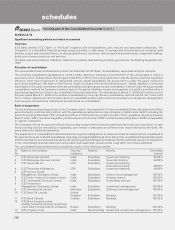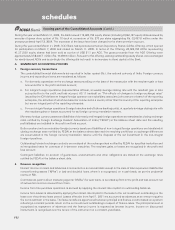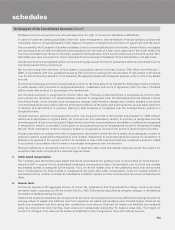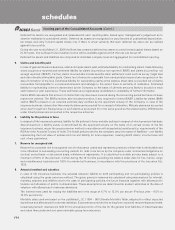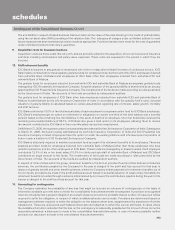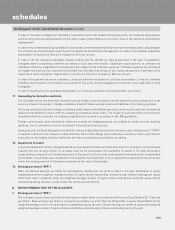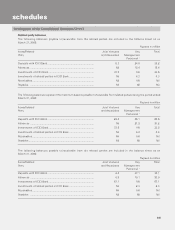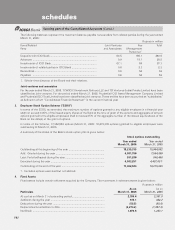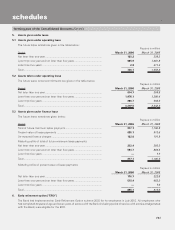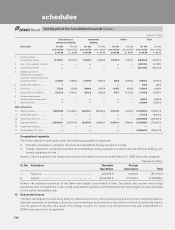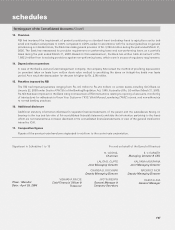ICICI Bank 2006 Annual Report Download - page 118
Download and view the complete annual report
Please find page 118 of the 2006 ICICI Bank annual report below. You can navigate through the pages in the report by either clicking on the pages listed below, or by using the keyword search tool below to find specific information within the annual report.
F59
In case of the asset management subsidiary, fixed assets other than leasehold improvements, and software development
and licensing costs are depreciated at written down value method based on economic lives of the assets as estimated by
management.
In case of the overseas banking subsidiaries, fixed assets other than leasehold improvements are depreciated using straight-
line method over the estimated useful lives of the assets as estimated by management. In case of the Canadian subsidiary,
depreciation on furniture & fixtures is charged @ 20% per annum.
In case of the life insurance subsidiary, assets costing upto Rs. 20,000 are fully depreciated in the year of acquisition.
Intangible assets comprising software are stated at cost less amortisation. Significant improvements to software are
capitalised while the insignificant improvements are charged off as software expenses. Software expenses are amortised
on straight-line method over a period of three years from the date they are put to use, being management’s estimate of the
useful life of such intangibles. Depreciation on furniture & fixtures is charged @ 25% per annum.
In case of the general insurance subsidiary, computer software are stated at cost less amortisation. Computer software
including improvements is amortised over a period of five years, being management’s estimate of the useful life of such
intangibles.
In case of housing finance subsidiary, depreciation on computer software is provided @ 20% per annum.
17. Accounting for derivative contracts
The Company enters into derivative contracts such as foreign currency options, interest rate and currency swaps and cross
currency interest rate swaps to hedge on-balance sheet/off-balance sheet assets and liabilities or for trading purposes.
The swap contracts entered to hedge on-balance sheet assets and liabilities are structured in such a way that they bear an
opposite and offsetting impact with the underlying on-balance sheet items. The impact of such derivative instruments is
correlated with the movement of underlying assets and accounted in accordance with RBI guidelines.
Foreign currency and rupee derivatives, which are entered for trading purposes, are marked to market and the resulting
gain/loss, (net of provisions, if any) is recorded in the profit and loss account.
During the year the Bank changed its method for testing hedge effectiveness from the price value of basis point (“PVBP”)
or duration method to the marked to market method. Due to this change certain derivative contracts, which were hitherto
accounted for as hedges, became ineffective and were accordingly accounted for as trading.
18. Impairment of assets
Long-lived assets and certain intangible assets are reviewed for impairment whenever events or changes in circumstances
indicate that the carrying amount of an asset may not be recoverable. Recoverability of assets to be held and used is
measured by a comparison of the carrying amount of an asset to future net discounted cash flows expected to be generated
by the asset. If such assets are considered to be impaired, the impairment to be recognised is measured by the amount by
which the carrying amount of the assets exceeds the fair value of the assets.
19. Earnings per share (“EPS”)
Basic and diluted earnings per share are calculated by dividing the net profit or loss for the year attributable to equity
shareholders by the weighted average number of equity shares outstanding during the year. Diluted earnings per equity
share have been computed using the weighted average number of equity shares and dilutive potential equity shares
outstanding during the year, except where the results are anti-dilutive.
B. NOTES FORMING PART OF THE ACCOUNTS
1. Earnings per share (”EPS”)
The Company reports basic and diluted earnings per equity share in accordance with Accounting Standard 20, “Earnings
per Share”. Basic earnings per share is computed by dividing net profit after tax attributable to equity shareholders by the
weighted average number of equity shares outstanding during the year. Diluted earnings per share is computed using the
weighted average number of equity shares and dilutive potential equity shares outstanding during the year.
schedules
forming part of the Consolidated Accounts (Contd.)



